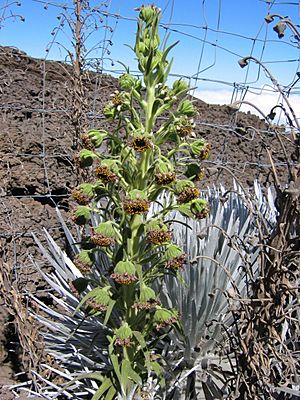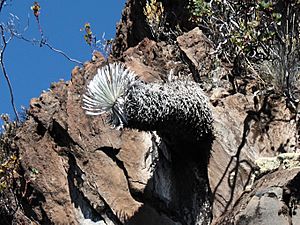Mauna Kea silversword facts for kids
Quick facts for kids Mauna Kea silversword |
|
|---|---|
 |
|
| Mauna Kea silversword on Mauna Kea (note protective fence) | |
| Conservation status | |
| Scientific classification |
|
| Kingdom: | Plantae |
| Clade: | Tracheophytes |
| Clade: | Angiosperms |
| Clade: | Eudicots |
| Clade: | Asterids |
| Order: | Asterales |
| Family: | Asteraceae |
| Genus: | Argyroxiphium |
| Species: | |
| Subspecies: |
A. s. subsp. sandwicense
|
| Trinomial name | |
| Argyroxiphium sandwicense subsp. sandwicense |
|
The Mauna Kea silversword, also known as Argyroxiphium sandwicense subsp. sandwicense, is a very rare flowering plant. It grows only on the island of Hawaiʻi, also called the Big Island, in the state of Hawaii. This special plant is like a "crown jewel" of the huge volcano, Mauna Kea. Its Hawaiian name is ʻahinahina. The Mauna Kea silversword was once common on the volcano. Now, amazing efforts are being made to save this unique plant.
Contents
What are Silverswords?
The Mauna Kea silversword belongs to a special group of plants called the silversword alliance. This group has about 50 different types of plants. All of them grow only in the Hawaiian islands. They are all very closely related, even though they look quite different.
Scientists believe they all came from one single plant species a long time ago. This is a great example of how plants can change and adapt very quickly. It shows how being isolated on islands helps new species to grow.
Meet the Mauna Kea Silversword
The Mauna Kea silversword is a plant that grows upright. It usually has one main stem, but sometimes it can have branches. It forms a round cluster of thick, sword-shaped leaves. These leaves are silvery-green and covered with soft, long hairs. They grow in a circle, like a rosette.
This rosette can be about 0.6 meters (2 feet) wide. Each leaf can be up to 0.3 meters (1 foot) long. The leaves are covered in a thick layer of shiny, silvery hairs. All silversword leaves have a special ability: they can store water as a gel inside them. This helps them survive in dry places.
Life Cycle and Flowering
The Mauna Kea silversword lives for many years before it flowers. It can live from 5 to 40 years! When it's ready, a tall flower stalk grows. This stalk can reach almost 3 meters (10 feet) high. It has many sticky branches with up to 600 flower heads.
Each flower head is about 2.5 centimeters (1 inch) wide. It has about 500 tiny individual flowers inside. Around the edge, there are pink to maroon petal-like flowers. Most flowering happens from mid-June to November. After the plant flowers, it usually dies. However, some rare plants have branches that flower and die separately. This means the main plant lives until its last branch flowers.
Other Silversword Types
There is another type of silversword called the Haleakala silversword. It grows in and around the Haleakalā volcano crater. The main difference between them is the shape of their flower stalk. The Haleakala silversword has a wider stalk. The Mauna Kea silversword has a narrower stalk. They also have a different number of petal-like flowers.
How it Adapted to its Home
Scientists think the Mauna Kea silversword came from a plant that lived in California. It probably reached Hawaii on a bird's feathers millions of years ago. This shows how seeds can travel very long distances across the ocean!
The Mauna Kea silversword learned to survive in very tough conditions. It grew in harsh, cold, and windy places where almost no other plants could live. However, it didn't need to develop ways to protect itself from animals that eat plants, like mammals. This is because there were no large plant-eating mammals in Hawaii for millions of years.
Many Hawaiian plants lost their defenses because they didn't need them. For example, Hawaiian raspberries don't have thorns. Hawaiian nettles don't sting. The silverswords' special ability to store water as a gel helped them live in dry areas. But they had no protection against new animals that arrived.
Its Original Home
Long ago, the Mauna Kea silversword was very common on Mauna Kea. It grew well in windy, open, high-up areas. These areas were between 2,600 and 3,800 meters (8,500 and 12,500 feet) high. The air there is very dry, and it mostly snows in winter.
It gets less than 51-102 centimeters (20-40 inches) of rain each year. Summers are very dry. There is no shade from the hot sun, and nights can be freezing cold any time of year. The soil is thin, rocky, and made of volcanic ash. In the highest parts of this area, no other plants can grow.
Early explorers in 1825 even used dead silversword stalks for firewood. In the 1920s, people said there were thousands of these plants. One person reported that the plants covered the slopes so much that the sun reflected off them. But by 1892, people noticed the plants were almost gone. They could only be found in very rough and hard-to-reach places.
Why it Almost Disappeared
The large number of silverswords quickly dropped to just a few plants. This happened because of decisions about how the land was used. In the 1790s, people brought animals like cattle, sheep, goats, dogs, and pigs to the islands. These animals, both pets and wild ones, ate the native plants.
By 1851, there were about 3,000 wild sheep and 12,000 wild cattle on Mauna Kea. Wild dogs used to help control the sheep population. But in 1921, the dogs were removed. After that, the number of sheep grew very fast. The number of Mauna Kea silverswords fell as the sheep population rose.
Live silverswords were only seen on cliffs where sheep couldn't reach them. By the 1930s, there were over 40,000 sheep on Mauna Kea. They destroyed the defenseless native plants, including the silverswords. Even though the number of wild sheep was reduced later, they were still protected for hunting until 1981. This was in areas where the silverswords used to live.
Saving the Silversword
At first, people tried to save the Mauna Kea silversword by building fences around the few remaining plants. But these fences didn't work well enough to keep out all the animals. In 1981, the state removed most of the wild sheep. But a new problem had arrived: mouflon sheep. These sheep were brought to the island in 1954 for hunting.
Mouflon sheep are more agile than wild sheep. They could reach even isolated plants and jump over fences. So, efforts to remove these animals started in 1988. Larger and larger fenced areas were built. Some wild plants were included inside these protected zones.
The Mauna Kea silversword was declared an endangered species in 1986. By 2003, only 41 naturally growing plants were left in the wild.
Growing New Plants
Growing new silversword plants started in the 1970s. At first, the results were not great. In 1984, a count found 131 plants. Only 15 of these were thought to be truly wild. The rest were grown in nurseries.
About 1,500 Mauna Kea silverswords were planted outside between 1973 and 1998. These plants grew to flower. However, they came from only one or two parent plants. This meant they didn't have much genetic variety. This led to some plants growing branches that flowered and died separately. Normally, the whole plant dies after it flowers once. By 1993, it was clear that a better plan was needed.
Increasing Plant Diversity
To make the plants stronger and more diverse, scientists started a special breeding program. They hand-pollinated flowering silverswords both in the wild and in nurseries. Hand pollination is when scientists carefully move pollen from one flower to another. This was the best way to help the plants reproduce and mix their genes.
Scientists grow young plants in nurseries and then plant them in protected areas. Over 80% of these planted silverswords survive. Since the plants only flower once after many years, leaving it to chance was too risky. Also, native insects that usually pollinate these flowers might have been harmed by new insect species.
The native Hylaeus bee is the natural pollinator for this plant. Honey bees visit the flowers but seem to take pollen without moving it between plants. So, scientists decided not to leave any seeds in the wild.
Hand-pollination is a difficult job. Scientists have to climb down cliffs to reach wild flowering plants. They use climbing gear to collect tiny yellow pollen grains in a small bottle. Then, they have to find another flowering Mauna Kea silversword. They use a small brush to put the pollen on the second plant's flower. If no other plant is blooming, they store the pollen.
Bringing the Species Back
The number of wild plants kept dropping quickly. About two plants were lost every year before they could reproduce.
In 1996, two wild plants flowered. Over 3,000 new plants were then planted, and more than 80% of them survived. In 1999, over 2,500 more silverswords were planted on Mauna Kea in protected spots. Plans were made to plant more every year. However, no other wild plants flowered until 2005.
In September 2005, 100,000 seeds were collected. These seeds came from hand-pollinated crosses between a wild plant and several planted ones. The success of planting new silverswords gives hope that this species can be saved. The United States Fish and Wildlife Service reports that there are now 8,000 silversword plants growing on Mauna Kea. However, they still came from only six original wild parent plants.



